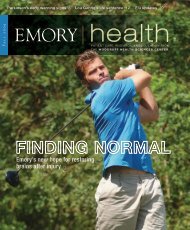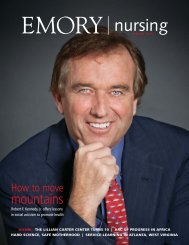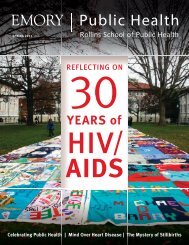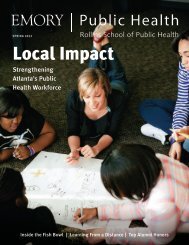returning quality to life - Woodruff Health Sciences Center - Emory ...
returning quality to life - Woodruff Health Sciences Center - Emory ...
returning quality to life - Woodruff Health Sciences Center - Emory ...
Create successful ePaper yourself
Turn your PDF publications into a flip-book with our unique Google optimized e-Paper software.
Critical care direc<strong>to</strong>r Tim<br />
Buchman is working <strong>to</strong> implement<br />
a policy <strong>to</strong> discuss difficult<br />
decisions when a patient enters<br />
the ICU rather than waiting for a<br />
full-blown crisis.<br />
<strong>to</strong> have a comfortable living area (including<br />
chairs and a sleeper sofa) for their families.<br />
Nearby, family members can make use of<br />
a room <strong>to</strong> teleconference with family and<br />
loved ones who can’t be there in person.<br />
<strong>Emory</strong>’s chief proponent of palliative<br />
care services, Tammie Quest, runs the VA<br />
unit. She supervises a staff that cares for<br />
1,000 palliative care patients (about half of<br />
whom are treated in outpatient clinics). It’s<br />
not surprising <strong>to</strong> her that the VA was among<br />
the first major medical systems <strong>to</strong> recognize<br />
the value of palliative care.<br />
“In recent years, <strong>quality</strong> of care has been<br />
paramount for the VA,” Quest says. “The<br />
care that we can provide is directly related<br />
<strong>to</strong> how patients measure their <strong>quality</strong> of<br />
care. You can’t get more basic than helping<br />
them feel better and allowing them <strong>to</strong><br />
decide what’s best for them.” EH<br />
Your nurse or doc<strong>to</strong>r can refer you <strong>to</strong><br />
a palliative care specialist at <strong>Emory</strong>, or<br />
you may call <strong>Emory</strong> <strong>Health</strong>Connection<br />
at 404-778-7777 for more information.<br />
Having the conversation<br />
The emergency department (ED) or ICU may be the<br />
worst place <strong>to</strong> hold “the conversation.” But without<br />
advanced planning, it sometimes becomes the only place.<br />
Estimates are that one in 500 patients who come <strong>to</strong> the ED,<br />
as many as 200,000 a year, do not live <strong>to</strong> be discharged from its<br />
constantly bleeping moni<strong>to</strong>rs and bright lights. Another 500,000<br />
patients die within days after being “tubed and moved”—<strong>to</strong> use<br />
the vernacular of the ED staff—from the emergency area <strong>to</strong> intensive<br />
care. Similarly, patients with end-stage chronic conditions like<br />
cancer and heart disease can wind up being admitted directly <strong>to</strong> the<br />
ICU in such a debilitated state that they can’t speak for themselves.<br />
Spouses, loved ones, and families who have never talked about<br />
what <strong>to</strong> do under such dire circumstances are often uncertain<br />
about the patient’s wishes. They need help sorting through decisions<br />
about how aggressive they want doc<strong>to</strong>rs <strong>to</strong> be and when—<br />
or under what circumstances—treatment should be s<strong>to</strong>pped.<br />
“Talking about what we want <strong>to</strong> be treated like at the end<br />
of <strong>life</strong> can be a hard conversation, but it doesn’t have <strong>to</strong> be,”<br />
says Woody Spackman, executive direc<strong>to</strong>r of <strong>Emory</strong>’s <strong>Center</strong> for Pas<strong>to</strong>ral Services. “It also<br />
can be a unifying moment for families, a chance <strong>to</strong> heal old wounds, and help each other<br />
understand what values we hold most dear. It makes many of the decisions that come later<br />
easier.”<br />
Chaplain Woody Spackman helps<br />
patients and families broach the<br />
difficult subject of how they want<br />
<strong>to</strong> be treated and the care they<br />
want <strong>to</strong> receive at the end of <strong>life</strong>.<br />
Starting the discussion Legal and ethical scholars point <strong>to</strong> a number of readily available<br />
documents (many of which can be downloaded from online websites) that individuals<br />
and families can use <strong>to</strong> specify their wishes. They range from advance directives <strong>to</strong> living<br />
wills <strong>to</strong> medical powers of at<strong>to</strong>rney, also known as durable powers of at<strong>to</strong>rney. While these<br />
documents differ slightly in form, many provide evidence of what the person wants in the<br />
event that he or she is unable <strong>to</strong> make decisions.<br />
Still, filling out the document and stashing it away in a desk drawer or a safe deposit box<br />
doesn’t go far enough, say experts, especially in families where there may be differences<br />
of opinion and strained personal relations over who is chosen <strong>to</strong> make decisions for the<br />
patient. It takes “the conversation.”<br />
Palliative and hospice care experts recommend holding a family meeting (at a holiday<br />
gathering, birthday, or wedding anniversary) <strong>to</strong> discuss end-of-<strong>life</strong> wishes. Often, the documents<br />
themselves prompt such discussions.<br />
Families may know, for instance, that their loved one doesn’t want <strong>to</strong> be intubated so<br />
that a machine is breathing for him, but they may be uncertain how he feels about the use<br />
of a feeding tube for nutrition even though there is no hope for recovery. That’s what makes<br />
the conversation so difficult. But rather than avoid it, experts say, families should confront it<br />
explicitly—sharing their expectations as well as their fears about death and dying.<br />
Winter 2011 7
















